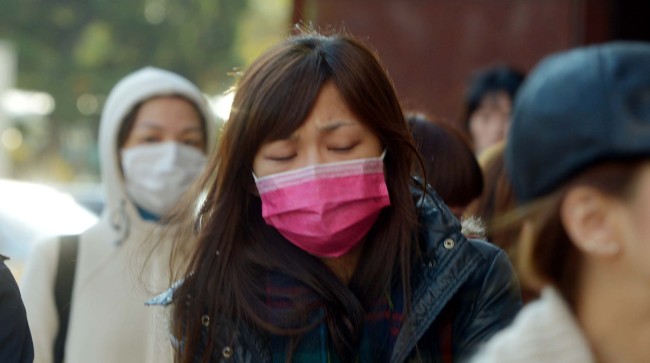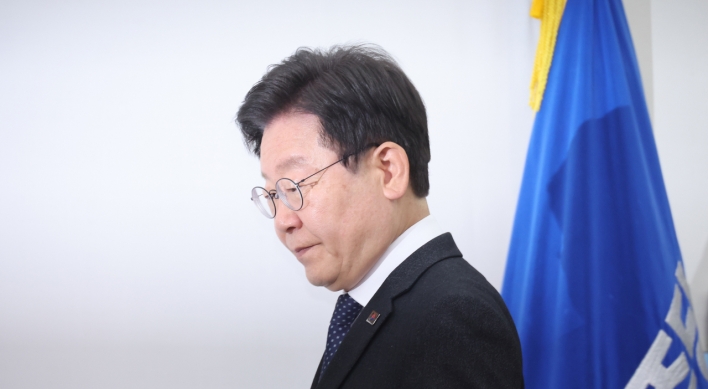
Health authorities are on alert over recently heightened levels of fine particles in the air, which can cause respiratory problems and other irritations in the eye, nose and throat.
About 30 times smaller than a human hair, ultrafine particles measure less than 2.5 micrometers across and are carried by the wind, much of them coming from cities in northern China, including Harbin and Beijing.
Recent studies showed they can directly enter the bronchial tubes and interfere with the gas exchange in the lungs.
This should be especially alarming to those who have weak respiratory and circulatory systems, and others who are vulnerable to viruses, says Lim Young-wook, assistant director of the Institute for Environmental Research at Yonsei University’s College of Medicine.
“What differentiates fine dust from yellow dust is that it is not a seasonal meteorological phenomenon. It’s produced through industrial development and carries significant amounts of metals such as lead, cadmium and copper,” Lim told the Korea Herald.
The accumulation of air pollutants is known to lead to cancer, diabetes, high blood pressure and even psychological diseases such as severe depression.
Dr. John G. Spangler, a professor of family medicine at Wake Forest Baptist Medical Centre, revealed this year that suicide rates in counties where coal-fired power plants operate were higher than elsewhere, suggesting that the quality of air can affect people suffering from different mood disorders.
Beijing’s concentrations of PM2.5 hit a record high of 993 micrograms per cubic meter earlier this year, 40 times more than the World Health Organization’s recommended standard of 25 micrograms.
The overall air quality index recently broke the 500 mark as well, the highest threshold on the Chinese scale.
Figures from monitoring stations in Korea showed that PM2.5 levels in the capital area on Oct. 29 recorded 65 micrograms per cubic meter, which is nearly double the annual average of 37 micrograms.
“We experts assume that this is likely to get worse in the next few months because Chinese cities begin firing up their coal-fired heating systems,” Lim said.
Mask sales in pharmacies and retail stores here have jumped nearly fivefold. Gmarket, one of the largest online retailers in Korea saw a 481 percent increase in masks sold between Oct. 24 and 30, from the same period last year, according to company officials.
A special type of a pollution mask that uses activated carbon cloth and has an extra layer is recommended, says Lim.
“People should keep their eyes on the weather forecast and prepare a mask if there are any westerlies coming. The wind going toward the peninsula (from China) is what carries all the pollutants,” Lim noted.
To deal with its neighboring country’s environmental problems, the South Korean government announced that it would begin nationwide fine dust forecasts next February.
The system will provide information on air quality affected by fine dust ― particles smaller than 10 micrometers per cubic meter ― on a scale of 1 to 5.
A forecast system for smaller particles, ultrafine dust, is expected to be implemented in early 2015, according to the environment ministry.
By Suk Gee-hyun (monicasuk@heraldcorp.com)
About 30 times smaller than a human hair, ultrafine particles measure less than 2.5 micrometers across and are carried by the wind, much of them coming from cities in northern China, including Harbin and Beijing.
Recent studies showed they can directly enter the bronchial tubes and interfere with the gas exchange in the lungs.
This should be especially alarming to those who have weak respiratory and circulatory systems, and others who are vulnerable to viruses, says Lim Young-wook, assistant director of the Institute for Environmental Research at Yonsei University’s College of Medicine.
“What differentiates fine dust from yellow dust is that it is not a seasonal meteorological phenomenon. It’s produced through industrial development and carries significant amounts of metals such as lead, cadmium and copper,” Lim told the Korea Herald.
The accumulation of air pollutants is known to lead to cancer, diabetes, high blood pressure and even psychological diseases such as severe depression.
Dr. John G. Spangler, a professor of family medicine at Wake Forest Baptist Medical Centre, revealed this year that suicide rates in counties where coal-fired power plants operate were higher than elsewhere, suggesting that the quality of air can affect people suffering from different mood disorders.
Beijing’s concentrations of PM2.5 hit a record high of 993 micrograms per cubic meter earlier this year, 40 times more than the World Health Organization’s recommended standard of 25 micrograms.
The overall air quality index recently broke the 500 mark as well, the highest threshold on the Chinese scale.
Figures from monitoring stations in Korea showed that PM2.5 levels in the capital area on Oct. 29 recorded 65 micrograms per cubic meter, which is nearly double the annual average of 37 micrograms.
“We experts assume that this is likely to get worse in the next few months because Chinese cities begin firing up their coal-fired heating systems,” Lim said.
Mask sales in pharmacies and retail stores here have jumped nearly fivefold. Gmarket, one of the largest online retailers in Korea saw a 481 percent increase in masks sold between Oct. 24 and 30, from the same period last year, according to company officials.
A special type of a pollution mask that uses activated carbon cloth and has an extra layer is recommended, says Lim.
“People should keep their eyes on the weather forecast and prepare a mask if there are any westerlies coming. The wind going toward the peninsula (from China) is what carries all the pollutants,” Lim noted.
To deal with its neighboring country’s environmental problems, the South Korean government announced that it would begin nationwide fine dust forecasts next February.
The system will provide information on air quality affected by fine dust ― particles smaller than 10 micrometers per cubic meter ― on a scale of 1 to 5.
A forecast system for smaller particles, ultrafine dust, is expected to be implemented in early 2015, according to the environment ministry.
By Suk Gee-hyun (monicasuk@heraldcorp.com)





![[Herald Interview] 'Amid aging population, Korea to invite more young professionals from overseas'](http://res.heraldm.com/phpwas/restmb_idxmake.php?idx=644&simg=/content/image/2024/04/24/20240424050844_0.jpg&u=20240424200058)











![[KH Explains] Korean shipbuilding stocks rally: Real growth or bubble?](http://res.heraldm.com/phpwas/restmb_idxmake.php?idx=652&simg=/content/image/2024/04/25/20240425050656_0.jpg&u=)

